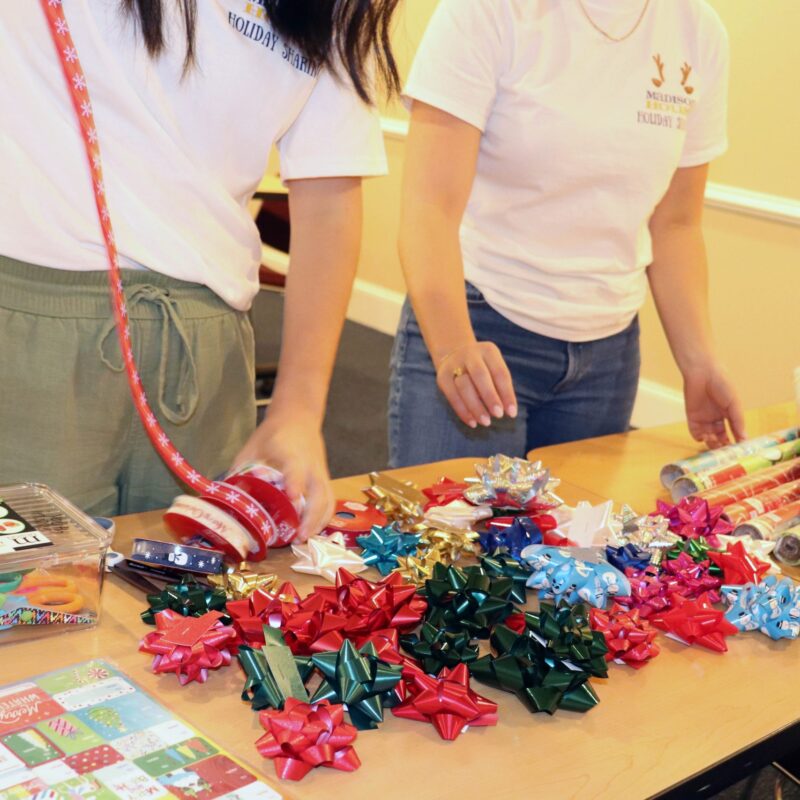“Turn it up,” says Will Anderson as the silver Ford E350 van rolls along Route 20 towards Fredericksburg. Alex Hargrave takes one hand off the wheel and cranks the volume on the stereo, which is tuned to 106.1 The Corner. “It’s Mejias,” Will says, referring to local pop singer-songwriter Alex Mejias, who’s playing a live set over the air to promote his concert at Satellite Ballroom that night.
|
A typical weekend in the life of Sparky’s Flaw: Pack the van, hit the road, take the stage…then do it all over again. iPhones and laptops keep them in touch, and fans keep them busy signing autographs and posing for photos. Tuning instruments in graffiti-covered rooms, selling CDs and t-shirts, shooting the breeze in the van, unloading equipment in a busy New York street—all of these are steps on the road to pop rock success. Hold on tight. |
Anderson and Hargrave would probably be attending Mejias’ show, but they’ve got their own show to get to. They started their first (and only) band, Sparky’s Flaw, in 2001 while attending Charlottesville High School, and sold more than 1,000 copies of their first album, Live from the Recording Studio, while still slamming lockers and sweating over tests.
Unlike most high school bands, though, Sparky’s Flaw didn’t call it quits after graduation. Anderson, who sings and plays piano and acoustic guitar, enrolled at UVA, while saxophonist and keyboardist Kit French stayed close by, attending Mary Washington College in Fredericksburg. Hargrave, who plays bass, and drummer Johnny Stubblefield also stuck around Charlottesville to keep the music going.
| Listen to "One Small Step" from Sparky’s Flaw‘s One Small Step EP:
|
The band released a four-song EP, One Small Step, in 2005 and since then they’ve fulfilled pretty much every goal that an ambitious young Charlottesville band could hope to achieve. In the spring of 2007 they signed with Red Light Management, part of Coran Capshaw’s music empire, and teamed up with producer Chris Keup, who has worked with artists like Jason Mraz, O.A.R and Jonathan Rice. The result was a second EP of five catchy, polished songs, and this past November the band announced that they had inked a deal with Mercury Records, part of the Island/Def Jam Music Group. In January they flew out to Los Angeles to begin recording their major label debut.
Mejias finishes a song and the DJ begins asking him some questions as Anderson’s iPhone rings. “Can you turn it down?” he asks Hargrave, who tweaks the knob again.
The call is from a journalist, and Anderson fields a few questions, answering in a confident and calculated tone. As the call ends, Mejias’ voice is still coming quietly out of the speakers, and Hargrave leans forward, trying to listen.
“He just said something about us.”
“He did?”
“Yeah, he just said something about Sparky’s Flaw.”
“What’d he say?”
“I think that he knew us when we were in high school.”
Mejias launches into his next song, strumming his guitar and singing, “Are you looking for something beautiful?” as an impatient driver on the road ahead crosses the yellow dotted line and makes a daring pass on the skinny two-lane highway.
“He’s going for it,” observes Hargrave, watching the car accelerate into the distance.
As the farmhouses fly by through the van’s cracked driver’s side mirror, 106.1 begins to fade towards static. Anderson pops in a CD by Elevation, a group that Sparky’s Flaw shared a bill with last weekend. It’s a cloudy Thursday afternoon and I’m just beginning my weekend with the band, heading towards the first of three shows, tagging along to find what it’s like to hang out with the next Dave Matth—ahem, I mean, Charlottesville’s Next Big Thing.
Let’s Be Friends
This isn’t the first time that Sparky’s Flaw has played Jammin’ Java, a haven of music, caffeine and tasty chicken salad sandwiches (or so Stubblefield tells me as he wolfs one down before the show) that sits amid the sprawling suburban landscape of Vienna, Virginia. Other Charlottesville musicians have played its stage, too, a fact that’s apparent when I spot Paul Curreri and Corey Harris stickers dotting the venue’s backstage corridor.
In a narrow room with red walls and three worn couches, the band members are preparing for their set. Stubblefield, wearing a small flat cap and stylish black-rimmed eyeglasses, sits on one side of the room with his MacBook Pro perched on his lap. Across from him, French changes into a new shirt before taking his saxophone out of its case and beginning to moisten the reed. Guitarist Nate McFarland, who joined the band in the fall of 2007 and, like Anderson, is in his final semester at UVA, tunes his butterscotch Fender Telecaster. Hargrave stares contemplatively at a pile of old records in the corner of the room, a Rick James cover gracing the top of the stack. Anderson writes up the night’s set list on sheets of notebook paper and passes them out. As Phil Bensen (the Michael Jackson-John Mayer hybrid who will open for Sparky’s Flaw all weekend) strums his final chord, Anderson says, “We roll, we roll” and they all jump up and begin carrying their equipment onto the stage.
The girls in the audience outnumber the guys by almost a three-to-one ratio and most of them (likely to the chagrin of the venue’s bartenders) appear to be under 20. They inch towards and gaze on expectantly as the band sets up. Some punch text messages into their phones while others giggle and whisper with their friends. The area of tables at the back of the venue is populated with a few parents who have taken the unnecessary precaution of chaperoning the night, unaware that Sparky’s Flaw won’t come close to any rock ‘n’ roll anarchy or rebellion during their set of radio-ready pop music.
It’s not all teenyboppers, though. Earlier, while Stubblefield leans on the merch table in the rear of the venue, two young women strike up a conversation with him. Both are recent UVA graduates, one says that she is now a paralegal and the other announces with satisfaction that she has just quit her job at a consulting firm.
“I’ve got both of your CDs and two of your t-shirts,” she tells Stubblefield.
“Well, this is a new one,” he says, pointing to a heather gray shirt with the band’s name in skinny white and black text atop rows of blue decibel bars, a design made by McFarland, “so you don’t have this one yet.”
“I’ve probably got enough, though,” she responds.
“I don’t think you can really say you have enough Sparky’s Flaw shirts until you have one for each day of the week,” he shoots back, making the two women laugh.
| Listen to "All That I Am" from Sparky’s Flaw‘s self-titled EP:
|
As Sparky’s Flaw begins their set, glowing screens replace expectant faces. Almost every girl in the audience seems to have a cell phone or camera, and as Anderson leans towards the microphone and sings the opening lines of “All That I Am,” I watch his silhouette fill the bright displays that bob above the crowd.
“How many of you are friends with us on Facebook?” Anderson asks halfway through the set. About a third of the hands in the room go up. “And how many of you are friends with us on MySpace?” Some hands go up and some go down, but the total stays about the same. “Well, if you aren’t, you can look us up,” he says. Only a couple hours after the show has ended, Anderson takes out his iPhone and checks his e-mail. “Already got three new friends,” he says.
Radio friendly
Sara Bareilles’ voice fills the van as the wet and foggy landscape of the New Jersey Turnpike rolls by. The record, 2007’s Little Voice, was produced by Eric Rosse. Sparky’s Flaw worked with Roose when they flew out to Los Angeles in January to begin working on their record, so it’s no surprise that they’re giving the disc a spin. When it comes to an end, Anderson switches to the radio and skips over Kanye West and Maroon 5 before coming across Anna Nalick’s “Breathe (2 AM),” another track produced by Rosse.
“Yeah, Eric!” says Stubblefield. The band members’ conversations are peppered with references to their time in Los Angeles, during which they finished around half of their album, which they expect to come out over the summer.
“We went to a casino when we were in L.A.,” Anderson tells me after the Jammin’ Java performance. “It was the most depressing thing ever. It was just gambling addicts. We didn’t win anything.” Jamie Sisley, one the band’s managers, gave them a lecture about money management after finding out, Anderson adds.
Though Chris Keup and Eric Rosse are producing the record, Anderson also met up with other professional songwriters and producers in L.A. “I wanted to meet up with people and get connected in that community,” he tells me. Though he tried collaborating with a few different writers, the only pairing that felt right was John Shanks, who has worked with Bon Jovi, Keith Urban, Lindsay Lohan and Stevie Nicks, just to name a few. “We wrote a song together and it’s definitely one of the best that I’ve done,” says Anderson, adding that Shanks will also produce three tracks on the album.
Though it’s on their minds, the band members talk as if their trip was no big deal. “It was just like recording in Charlottesville, except we were in L.A.,” Anderson says. “Nate would wake us up every morning, walking around naked. Then we’d shower and go out to the beach or shopping for the morning, and then we’d record with Eric until 8 or 9.”
In the van’s cramped back seat, which the band jokingly calls the “pleasure pod,” French is reclining, his feet resting on top of guitar cases. In front of him, McFarland and his girlfriend Catherine, who has come along for the weekend to help sell t-shirts and CDs, are talking quietly with each other. Stubblefield sits next to me, propping his head against a pillow and staring out the window. Hargrave, in the front passenger seat, reads off the list of vitamins on the bottle of the Peach Mango Fuze drink that he bought at the last rest stop.
“B-12. That’s a good one,” he quips.
“What does it do?” asks Stubblefield.
“I’m not sure.”
Anderson is at the wheel, his iPhone earbuds dangling around his neck, as he’s been taking phone calls while he drives. A GPS system mounted on the dashboard shows a small map of the route we’re traveling. The white arrow on the screen points straight ahead.
Through the front window, the city skyline materializes out of the mist, and, after Anderson fishes a few bills out of the jumble of chips, cans and CDs that clutter the dash, he pays the $6 toll for the Holland Tunnel and the day’s monotony comes to an end. As the lights of the tunnel flicker through the van, everyone sits up in their seats and prepares to greet the impending bustle of buildings, cars and people. A motorcyclist rumbles past, sporting a shiny leather jacket. Across the back are stitched the words “New York.”
Joyride
A bored-looking man sits inside the ticket booth of the Knitting Factory, a club in lower Manhattan. The band leans against the walls of the entranceway as two girls walk in from the street, glancing up they pass by and approach the booth, where a chalkboard sign reads:
“TAP BAR
7:00 – Phil Bensen
8:15 – Scott Harris
9:15 – Sparky’s Flaw”
“Two tickets for Sparky’s Flaw,” they tell the man.
“Yeah!” shouts Anderson with a smile as the two girls take their tickets and walk back towards the door, timidly stopping to introduce themselves to the band.
“One of our friends from Virginia told us about you guys,” says Nicole, a freshman at SUNY New Paltz near Poughkeepsie. She and her companion, Courtney, took a two-hour train ride into the city to see Sparky’s Flaw. Though the show will not start for another four hours, they linger outside the club as the band unloads the van (no easy task, given the narrow, one-way street in front of the venue) and carries their equipment down a flight of stairs to the 200-person capacity Tap Bar.
| Listen to "Under Control" from Sparky’s Flaw‘s self-titled EP:
|
Though the two girls never mention it, there’s likely one main reason that they are fans of Sparky’s Flaw, much more important than their friend from Virginia: MySpace. A visit to the band’s page on the social networking site provides an effortless introduction to everything Sparky’s Flaw. A bright image of the band in the shape of their logo sits at the top of the page advertising the fact that their EP is available on iTunes. The bouncing, Maroon 5-ish tune, “Under Control,” automatically starts playing, and, as one takes in the slick melodies and Anderson’s sugary, romantic lyrics, there are many other options: buy a t-shirt, download a Sparky’s Flaw banner for your own MySpace page, make the band your desktop background or watch a video of them goofing off in the recording studio. Nicole and Courtney probably already felt like they knew Sparky’s Flaw when they got off the train and headed to the Knitting Factory, but they end up getting more than just the band’s digital friendship.
After piling their equipment next to the stage and neatly organizing their shirts and CDs on a table in the back of the room, the band decides to get back in the van and take a drive around the city. On the way out, Anderson spots the two girls.
“You guys want to go for a ride with us?”
“Uh, sure,” they say, following him to the van and piling in with the rest of us. The GPS system is our guide, as none of the band members are very familiar with navigating the city, and Stubblefield, who’s at the wheel, plugs in Ground Zero into the device as the first destination.
With night beginning to fall and the streets still wet with rain, the view from the van has an extra twinkle to it. As we head south into the Financial District, the eerie open space where the World Trade Center towers once stood emerges on the left. One of the band members asks the girls what they are studying in school. “We’re both going to be school teachers,” says Nicole. The girls are short spoken, still struggling to grasp the two objects of awe before them—the sprawling scene that’s passing by through the windows and this chance to hang out with the members of Sparky’s Flaw, who have suddenly leapt out of their iPods and computer screens and swept them off into the New York night.
The lights of the South Street Seaport and the dark waters of the Hudson River come into view, and I imagine the girls one day telling their students how once, when they were in college, they got to hang out with Sparky’s Flaw, the famous rock band.
Sparky’s Flaw isn’t famous yet, though. Like any other band working to build an audience, they’re spending the weekend away from home, traveling in a cramped, messy van to play a few shows and make a few new fans. As the girls get a glimpse of this perspective, they seem more at ease. These guys, who they’ve only known through flashy press photos and mp3s, aren’t so different from themselves. Sure, the band spent the winter break in L.A. recording their first major label album, but they are staring out at the city and treating the girls like normal friends who just happen to be along for the ride. Stubblefield turns onto the entrance ramp of the Brooklyn Bridge, and as we cross over the East River, even I am caught up in the moment, feeling like we are all the same—just some kids packed into a van, soaking up the energy and rush of everything around us.
The GPS soon leads us back to Manhattan and the Knitting Factory, and the band makes their way back into the club, leaving Nicole and Courtney to wait for the doors to open and reflect on what will most definitely be the high point of their day, even though the show they’ve come to see doesn’t start for another two hours.
No sleep ’til Brooklyn
“It’s my job to defend the band,” says Chris Sampson, Sparky’s Flaw’s other manager. “The record label people always think that they should be writing songs or recording. But it’s really important for them to get out and play shows. It’s just so awesome to see a band that plays with so much energy.” Sampson, who just relocated from Red Light Management’s Charlottesville offices to work in the company’s New York headquarters, is sitting next to me in the Tribeca Grand Hotel’s trendy, candle-lit cocktail lounge, where he, the band and a posse of friends are celebrating the success of the evening’s Knitting Factory show.
Sampson’s tone makes it clear that he’s not just delivering a promotional pitch for one of his clients. He’s truly enthusiastic about the band, and his perspective mirrors that of Red Light and the rest of Coran Capshaw’s musical empire, which focuses more on the live experience and merchandise rather than CD sales. And this is why Sparky’s Flaw, though three members still spend weekdays working for their college degrees, are on the road almost every weekend.
It’s nearing 2am and I can see the effect of that nonstop activity on the faces of the band. Hargrave and McFarland sit quietly at one corner of the table, their eyes are almost shut. “We could ask them if you can just spend the night here,” jokes Sampson.
“We’ve never been on the road longer than five days or so,” Hargrave tells me earlier that night, adding that once Anderson, McFarland and French graduate in May, the plan is to be on the road about nine months a year. A night’s rest does eventually come, but only after a trek across the city and the inflation of an air mattress on the floor of a friend’s Brooklyn apartment.
Teenage paradise
The Saturday night crowd at the Trackside Teen Center in Wilton, Connecticut, is, well, pretty much what you’d expect: teens. Amid the young crowd are the familiar faces of Nicole and Courtney, who, wooed by the previous day’s adventure, have traveled once again to see band. The Center, which seems to be a place where the upper class population of Wilton keeps its high school-age children occupied on weekend nights, boasts a video game room, a small movie theater, a snack bar, pool and foosball tables and a large concert hall called The Barn, where Sparky’s Flaw will play their final show of the weekend.
Anderson sits on a couch in the back room of the Center, reading and taking notes on an essay titled “Two-Point Counterpoint” for one of his music classes at UVA. But while he tries to catch up on his musical education, his musical career beckons. As he leaves the room with the rest of the band to set up equipment, he’s only jotted a few lines of in his notebook, and the essay is still open to the first page.
When Sparky’s Flaw takes the stage around 10:30pm, they play a short set, as the Center has an 11pm curfew. The crowd dwindles to fewer than 50 as some parents pick up there kids early, and the night is far from the frenzy and buzz of Friday’s Knitting Factory show, when friends, label representatives and fans packed the Tap Bar to see the band play a tight, energetic set. But after Sparky’s Flaw finishes their last song and leaves the stage, the girls who have stuck around eagerly line up for autographs and photos. The band ends up spending as much time making small talk with their young fans, scribbling their names in Sharpie and posing for pictures as they did playing music. Once the Teen Center is finally empty, they pack their gear up with smiles on their faces. A long drive back to Charlottesville lies ahead, but the band seems refueled by the night’s youthful enthusiasm.
It’ll be a busy spring for Sparky’s Flaw, with more weekend jaunts and other obligations squeezed between classes and jobs. On February 12, they perform at Heist, an event at Satellite Ballroom sponsored by Toyota’s youth-oriented line of Scion cars. In March, they’ll head to Austin, Texas, to play showcases at South By Southwest, a massive four-day music industry-oriented festival. And on March 21, they’ll return to Satellite Ballroom to co-headline a show with another promising local band, Sons of Bill. Along they way they’ll finish up their album, sign some more autographs, grab a few diplomas and make many more friends on MySpace as they take a few more steps towards becoming rock stars.






